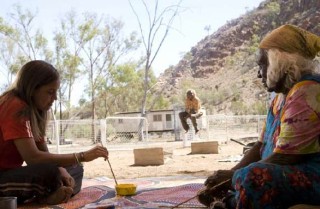ArtsGuide Community

Samson and Delilah brings the house down
I am not a fan of hard core realism in film, nor do I enjoy its opposite - fantasy.
I resent a film which is layered in clichés and yet manages to suck a cheap tear out of me. And save me a Hollywood happy ending, please! If it doesn’t transform our lived reality in some way – make us see things differently, as is the purpose of art, then a film should at least raise our social consciousness, make us more human. (at this point I feel like I should perhaps tone down my opinionated self by telling you that I do also ‘enjoy’ a light comedy at a suburban cinema from time to time, but then I question my motive behind this need to excuse my self, after all, deep and meaningful is not offensive, perhaps somewhat out of fashion…or annoying at the lunch table at work for some … anyway)
Samson and Delilah shook me up, and the reaction was somewhat delayed, like in a trauma or grief. The film was deeply sad, as well as funny, warm, etc., but not in the way that it evokes sentimental tear shedding, which Hollywood scale films like Australia did in its dealing with the stolen generation issue for example. As important as films like Australia, and Ten Canoes, and Rabbit Proof Fence were for our Australian social consciousness, Samson and Delilah is a different ball game altogether, confronting us head on with the naked facts of young disadvantaged lives of indigenous fringe dwellers in central Australia; lives filled with boredom, trauma, drug abuse. As my colleague Heather Casteldine (Indigenous Mental Health) poignantly commented, ‘White Australia wasn’t ready for Samson and Delilah five years ago. We had to have the other films first’. Perhaps we have progressed as a nation then.
But why would someone who works in the field of social services and who would see kids like Samson Monday to Friday, go to a movie like this on the weekend? Wouldn’t you just want to be getting away from the work thing to see the latest Arnie/Transformers flick? Well, because you expect that a film, if good, would shed some new light on the suffering you might hear about from clients, and thus by seeing it from a different perspective, you would be enlightened in some way. That is what art does to us at best. To a degree Samson and Delilah did this for me; and you won’t catch me wearing my psychologist hat and professional boundaries when I go to see a movie on the weekend – I am just human, and this allows me to connect with the suffering on a much more personal level.
The elements of hope in the film that were real for me was not the somewhat sudden happy ending - it just happened to quickly, was rounded off too neatly, given the suffering that was presented for the greater length of the film. Hope was in Delilah painting and carrying on the tradition of art passed onto her by her grandmother; hope was Samson speaking his name out loud (the only time he speaks in the film I believe), or Samson coming home with a kangaroo over his shoulder for the evening meal; hope was the ever present possibility, no matter how remote, at the start of each new day – the most visually beautiful and subtle shots were of Samson rising of a morning - reminding us of the potential beauty and hope embedded in the mundane rituals of our lives, no matter how difficult.
From a socio-cultural perspective a must see film. Young director shows great promise.
4 Stars ****
Lidija Medosh is the author of "War Is Not the Season for Figs" UQ Press 2004


